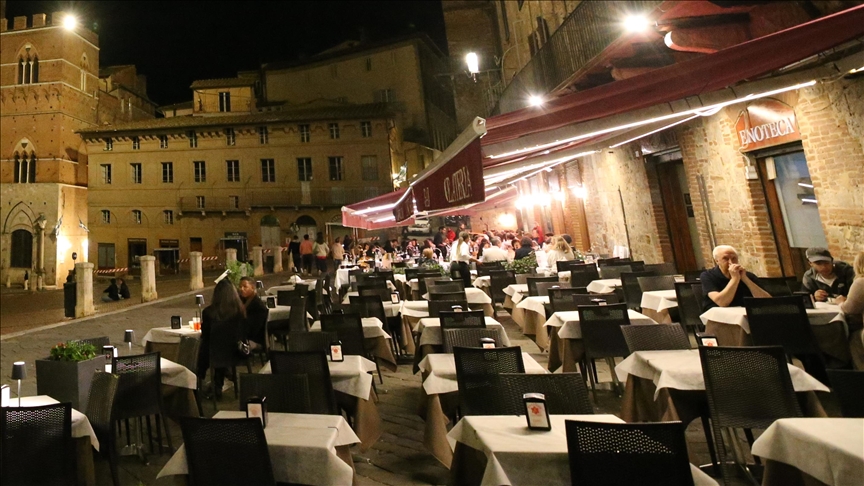Smoke-free Milan? New ban ignites debate on liberties
Milan has banned smoking in outdoor public spaces starting Jan. 1, sparking a debate among proponents of public health and personal freedoms
 FILE PHOTO
FILE PHOTO
- Milan has banned smoking in outdoor public spaces starting Jan. 1, sparking a debate among proponents of public health and personal freedoms
- ‘This is not a battle against smokers. It is a battle to promote respect for people,’ Anna Scavuzzo, Milan’s deputy mayor, tells Anadolu
- ‘It seems right to me not to smoke indoors, but in the open air one must be free,’ says local resident Vincenzo Balatti
MILAN
On a bright, sunny afternoon in Milan, the Piazza del Duomo, with its iconic Gothic cathedral and a towering Christmas tree, is alive with activity.
The square is bustling with locals and tourists alike, many of whom are taking advantage of the post-Christmas sales, eagerly searching for bargains in the surrounding shops.
Among the crowd, some people can be seen smoking, both traditional cigarettes and electronic alternatives. Some smokers tuck themselves into corners, attempting to be discreet, while others puff away just inches from children in strollers.
However, many are unaware that Milan has implemented a ban on smoking in outdoor public areas starting Jan. 1.
Smoking outdoors is now only permitted in designated areas, provided smokers maintain a minimum distance of 10 meters (33 feet) from others. Those who violate the rule face fines ranging from €40 to €240 ($43 to $258).
The measure, part of Milan’s larger initiative to cut carbon dioxide emissions by half by 2050, has sparked heated public debate, with proponents of public health and civil liberties on either side of the divide.
“This is not a battle against smokers. It is a battle to promote respect for people,” Anna Scavuzzo, Milan’s deputy mayor, told Anadolu.
“We have included this new rule in the municipality regulation. I would like to make clear this is a real rule and there will be fines, especially for those who behave in a deliberately provocative manner, or for those who do not realize that they are really causing a problem for the people around them.”
Scavuzzo emphasized that cigarette smoking contributes to 7% of fine dust emissions in the city, underlining the environmental and health motivations behind the ban.
“Milan is working hard on both health and air quality. Promoting an outdoor smoking ban and asking smokers to move away from people means protecting non-smokers and allowing them to have cleaner air,” she added.
An ‘ideological battle’?
Vincenzo Balatti, a local smoker, expressed his frustration over the measure.
“It seems right to me not to smoke indoors, but in the open air one must be free. I am against this measure because, in my opinion, it is something that will never be feasible, especially in places like Piazza del Duomo where there are so many people,” he said.
On the other hand, Eugenio Murone, who previously suffered severe health issues due to smoking, supports the ban wholeheartedly.
“I completely agree with this measure. Smoking is bad for health, and I know this because I got cancer from smoking. If everyone stopped, we would save on health. It is true that the state would collect less tax, but we would save in health costs. No one should smoke anymore,” he argued.
While public opinion remains split, the scientific community has largely applauded the initiative.
Renowned Italian oncologist Silvio Garattini, a lifelong advocate for public health, praised the ban.
“It is a choice that I have been suggesting for a long time because passive smoking is profoundly unfair. In Italy, we have at least 500 deaths a year from multiple illnesses that derive from it, and we have 50 billion cigarette butts polluting our country every year,” Garattini said.
However, not all reactions have been supportive. Marco Barbieri, secretary general of the Milan chapter of Confcommercio, the Italian retailers’ association, criticized the ban, describing it as “an ideological battle overcome by the evidence of data.”
Personal liberty or public responsibility?
Beyond the debate over personal freedoms and public health, many citizens and tourists have raised concerns about the lack of clear communication regarding the new rules.
Few signs or public notices inform people of the ban or the fines of up to €240 that violators could face.
The absence of designated smoking areas has also become a focal point for critics who argue that the city’s current approach feels more punitive than constructive.
“There should be clear signs warning people about the ban,” said Alessandro Ioppolo, a smoker who continued to light up during his interview.
“I think it is right not to smoke in the open air and near people. But special areas should be created where smokers can smoke without disturbing others.”
This recent expansion of the outdoor smoking ban is not Milan's first attempt to curb smoking in public spaces. In 2021, the city council introduced a ban on smoking in parks, at public transport stops, and in the stands of the San Siro stadium.
Despite these rules, enforcement has been minimal, with only 14 fines issued for violations since the ban was enacted.
This has raised questions about how effectively the new ban in crowded areas like Piazza del Duomo will be enforced.
Many recall the early skepticism surrounding the Sirchia Law, implemented in 2005 by then-Health Minister Girolamo Sirchia, which prohibited smoking in bars and restaurants. Initially met with doubt, the law quickly gained widespread compliance and is now considered one of the most successful public health policies in Italian history.
The current debate also touches on a broader dating back to philosophers like Immanuel Kant, about where to draw the line between personal liberty and public responsibility.
“I think that freedom ends when someone else feels attacked. If I exercise a freedom that bothers someone else, this freedom must be limited from my point of view,” said Sara Capasa, a local resident.
“Of course, this creates clashes. But my freedom ends when someone else’s begins.”
Anadolu Agency website contains only a portion of the news stories offered to subscribers in the AA News Broadcasting System (HAS), and in summarized form. Please contact us for subscription options.







